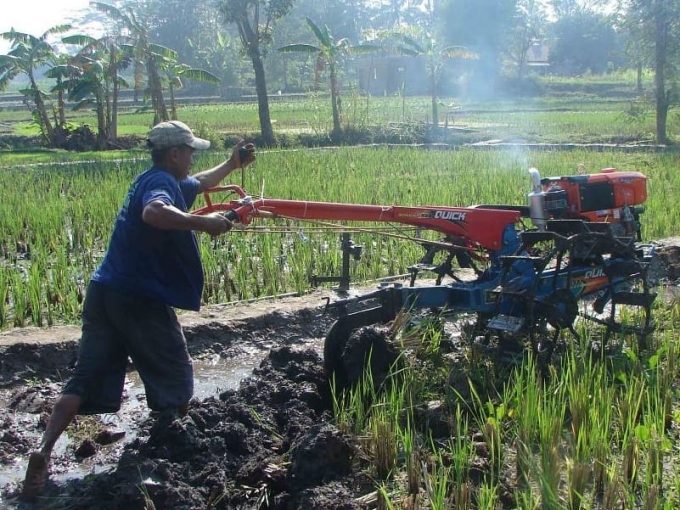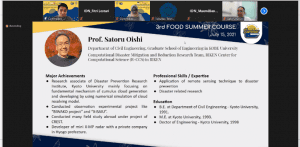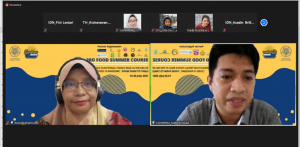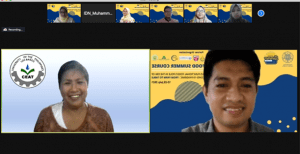
The third day of the 3rd summer course on food with the theme of Local Indigenous Functional Food’s Roles in The Era of Covid19 Pandemic: From Farm to Table was held on July 15th, 2021. On this day, the event consisted of four sessions, including a lecture from Prof. Satoru Oishi from Kobe University, virtual trip and discussions, material elaboration by Prof. Ts. Dr. Rosnah Shamsudin from Universiti of Putra Malaysia and material elaboration by Prof. Rossana Cablyan-Amongo from University of the Philippines Los Banos.
 In the first session, the material elaboration by Prof. Satoru Oishi about “Practical Application of Weather Radar Information in Japan.” In this session, Prof. Satoru explained the potency of disaster in Japan. Because in Japan, natural disasters often occur, the government and academic universities make innovations and development to minimize its impact. Mini Radar Development is called “Furuno.” Furuno, as compact weather radar, can be used for different purposes. There are energy, recreation, agriculture, water treatment, operation management, and disaster prevention. Prof Oishi also explained in the presentation that the difference between this Furuno Radar to the regular weather forecast report from the local officials or even weather forecast application in the smartphone. The display image shows information about the forecast water level at a point and in the river. We can calculate the water level very accurately with this data and graph.
In the first session, the material elaboration by Prof. Satoru Oishi about “Practical Application of Weather Radar Information in Japan.” In this session, Prof. Satoru explained the potency of disaster in Japan. Because in Japan, natural disasters often occur, the government and academic universities make innovations and development to minimize its impact. Mini Radar Development is called “Furuno.” Furuno, as compact weather radar, can be used for different purposes. There are energy, recreation, agriculture, water treatment, operation management, and disaster prevention. Prof Oishi also explained in the presentation that the difference between this Furuno Radar to the regular weather forecast report from the local officials or even weather forecast application in the smartphone. The display image shows information about the forecast water level at a point and in the river. We can calculate the water level very accurately with this data and graph.
In the second session, the participants joined virtual community visits of socioentrepreneurship based on Curcuma mangga cultivation by Prof. Dwiyati Pujimulyani. Then the participants discussed the pros and cons of community empowerment based on Curcuma mangga cultivation and compared the video with other community empowerment.
 In the third session, the lecture was delivered by Prof. Ts. Dr. Rosnah Shamsudin about “Drying Plants, Herbs, and Species to Preserve Their Active Compounds.” Professor Rosnah divided her material into three sub-topics, including introducing plants, herbs, species, and active compounds, preserving active compounds by using drying methods, and the different types of drying methods. There are various types of herbs and spices used to make our food more delicious or have the advantage of making our life healthier. Advances in dehydration techniques and the development of novel drying methods have in recent years enabled the preparation of a wide range of dried products and convenience foods, meeting the quality, stability, and functional requirements coupled with the economy.
In the third session, the lecture was delivered by Prof. Ts. Dr. Rosnah Shamsudin about “Drying Plants, Herbs, and Species to Preserve Their Active Compounds.” Professor Rosnah divided her material into three sub-topics, including introducing plants, herbs, species, and active compounds, preserving active compounds by using drying methods, and the different types of drying methods. There are various types of herbs and spices used to make our food more delicious or have the advantage of making our life healthier. Advances in dehydration techniques and the development of novel drying methods have in recent years enabled the preparation of a wide range of dried products and convenience foods, meeting the quality, stability, and functional requirements coupled with the economy.
 In the last session, the material elaboration by Prof. Rossana Cablyan-Amongo about “Agricultural Machinery.” Prof Rossana divided the lecture into seven topics: production systems, prime movers, tillage machinery and equipment, crop establishment machinery, crop care machinery, water pumping equipment, and harvesting and threshing machinery. She said the source of power on the farm is human power, animal power, electric motors, internal combustion engines, and renewable energy. As the oldest source of power, humans or manpower are still considered one of the significant sources because of the size of the farm, topography, crops grown, and availability of low-cost labor.
In the last session, the material elaboration by Prof. Rossana Cablyan-Amongo about “Agricultural Machinery.” Prof Rossana divided the lecture into seven topics: production systems, prime movers, tillage machinery and equipment, crop establishment machinery, crop care machinery, water pumping equipment, and harvesting and threshing machinery. She said the source of power on the farm is human power, animal power, electric motors, internal combustion engines, and renewable energy. As the oldest source of power, humans or manpower are still considered one of the significant sources because of the size of the farm, topography, crops grown, and availability of low-cost labor.
